Depending on where you live, you may hear a few different terms to describe canyoneering or canyoning. It may be an activity that interests you, or it might be a hashtag that you’ve seen on Social Media.
What is the Difference Between Canyoneering and Canyoning?
Canyoning and Canyoneering are the same thing. In the US it is called Canyoneering, while in most of Europe it is called Canyoning. Other regions of the world call it other things, such as River Tracing, Kloofing, Barranquismo, and Gorge Walking.
Of all my favorite outdoor sports, most of them involve ropes and climbing of some kind. They are all so similar in gear, technique, even slang, yet so different at the same time. Here’s the difference between all the rope sports and the basic ideas of each.
Canyoneering, Canyoning, Rappelling, Abseiling, Rock Climbing, Caving, Mountaineering, and Via Ferralta.
What is Canyoneering?
Canyoneering is travelling down through a canyon and using different techniques of rock climbing and rappelling to navigate. Canyoneering is the common word used in the U.S. for the technical hike down through canyons. Canyoneers is the term used to describe someone canyoneering. It’s pretty much the best of it all, combining all my favorite adventures: hiking, down-climbing, scrambling, rappelling , rock climbing/bouldering, and sometimes cliff jumping and swimming. It is the ultimate sport! Canyoneers need to be experienced in each of these sports for a safe route through a canyon.
, rock climbing/bouldering, and sometimes cliff jumping and swimming. It is the ultimate sport! Canyoneers need to be experienced in each of these sports for a safe route through a canyon.
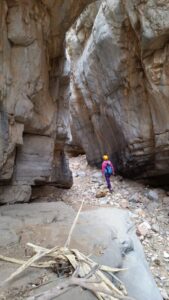
How to plan a canyoneering trip:
When planning a canyoneering trip, always check the weather! Canyons are dangerous in flash floods, so never go into a canyon if there is a chance of rain. Most canyons are just a couple miles long and take a few hours. Also, look up the rating system of the canyon beforehand so you can pick one for your skillset. Be prepared with detailed instructions, adequate maps, and know the required equipment you’ll need for a canyoneering trip. We always like to know how many rappels there will be and how long of a rope is needed. I always bring at least one person with me and we tell a friend where we are going and when we expect to be back. When you get there, usually there is a hike involved to reach the canyon (unless you can park close) and then you either walk down into it or rappel into the canyon to start. Then the adventure begins! You follow the canyon, sometimes crossing a river and swimming, rappelling
into the canyon to start. Then the adventure begins! You follow the canyon, sometimes crossing a river and swimming, rappelling down cliffs, maneuvering over boulders, and finding your way around other obstacles. It takes a lot of team work and expertise in the different areas.
down cliffs, maneuvering over boulders, and finding your way around other obstacles. It takes a lot of team work and expertise in the different areas.
Gear needed for Canyoneering: Helmet
for Canyoneering: Helmet , static rope, harness
, static rope, harness and hardware, canyoneering shoes,
and hardware, canyoneering shoes, gloves, a rope bag, slings, and extra carabiners. Occasionally you’ll need a wetsuit, dry bag (to keep phones, keys, and snacks dry if there are swims), lifejacket or other buoyancy aid as well, so be prepared and know before you go!
gloves, a rope bag, slings, and extra carabiners. Occasionally you’ll need a wetsuit, dry bag (to keep phones, keys, and snacks dry if there are swims), lifejacket or other buoyancy aid as well, so be prepared and know before you go!
Types of canyons:
- Slot canyons- a slot canyon is a narrow canyon formed by water. They are usually deep but not very wide. It can mean some fun maneuvers over any stuck log or boulder, as well as some tight squeezes.
- Box canyons- A box canyon is like a slot canyon, it is narrow with one entrance and one exit because of the steep cliff walls running through the whole thing.
- Gorges- A gorge is a narrow valley between mountains, with steep cliff walls and sometimes a stream running through it.
- Wet vs Dry canyons- Basically these mean what they sound like. Refers to a canyon that either requires swims or doesn’t.

Popular places to go canyoneering: Popular destinations for canyoneering include Costa Rica, Utah, Philippines, New Zealand, UK, etc. however the landscape of many states and countries offers canyoneering of some sort.
If you are going on vacation and looking for adventures, try canyoneering. It is a great way to experience a new destination! Most areas have canyoneering guides that organize trips and know the area well. Even if you have the skill to go canyoneering on your own, try looking into a guided trip (and then you won’t have to pack your own gear). A guide can also show you the ropes if you are a beginner. They can teach you technique, safety tips, and give recommendations on local spots to try when you’re experienced. If you are planning a trip on your own, it is important to read up and become familiar with the local area, terrain, and challenges before you go. Have back up plans ready and be prepared so you’re ready for any danger spots.

What is Canyoning?
What is the difference between Canyoneering and Canyoning? The difference is mostly a cultural/ language difference. “Canyoneering” is a term almost exclusively used in the U.S., where areas like Australia refer to the same thing as “canyoning.” If there is a difference between the terms, it isn’t very major. Some may refer to canyoneering as a specific type of canyoning. Canyoneering isn’t as physically demanding and difficult, it refers to dry canyons with only a little water flow, where the term canyoning may imply following a canyon with a source of water.
Canyoning is also called gorge walking. It is used to describe human white water rafting without a boat. You maneuver through a water filled gorge by swimming, crossing rocks, and clambering over anything in your path and use many different ways to overcome obstacles. This is done in areas where water has cut unusual shapes and unique patterns through the rocks. There are some fairly technical canyons available, but others can be found more for pure enjoyment with cliff jumps and natural water slides that are more accessible for all levels.
What is Rappelling ?
?
Rappelling is using a rope to lower yourself down a cliff. It is a fairly simple action, when done correctly, to descend in a controlled and safe manner. To rappel, a rope
is using a rope to lower yourself down a cliff. It is a fairly simple action, when done correctly, to descend in a controlled and safe manner. To rappel, a rope is looped and tied through the anchors at the top of the cliff, the person wears a climbing harness and rappel device
is looped and tied through the anchors at the top of the cliff, the person wears a climbing harness and rappel device  to connect to the rope, and uses their hands to move down the rope
to connect to the rope, and uses their hands to move down the rope .
.

How to rappel: To begin the descent, come to the edge of the cliff and, while facing the cliff, lean back against the rope Once you are in a sitting position with your legs in front of you at a 90 degree angle to your torso, use your hands to feed the rope
rappel: To begin the descent, come to the edge of the cliff and, while facing the cliff, lean back against the rope Once you are in a sitting position with your legs in front of you at a 90 degree angle to your torso, use your hands to feed the rope through your rappel device
through your rappel device and slowly walk down the cliff. You can go as slow or as fast as desired, always keeping your hands on the rope to control speed. Rappelling may or may not involve a belayer to also control speed of descent. You can even rappel without a harness
and slowly walk down the cliff. You can go as slow or as fast as desired, always keeping your hands on the rope to control speed. Rappelling may or may not involve a belayer to also control speed of descent. You can even rappel without a harness (not recommended, but possible.) Check out our posts on how to rappel and how to stay safe while rappelling.
(not recommended, but possible.) Check out our posts on how to rappel and how to stay safe while rappelling.
Rappelling is a sport by itself, and it is also involved in rock climbing, canyoneering, and caving. Pictures of rock climbing and rappelling look the same because the set up can be identical, but the person may either be on their way up rock climbing or rappelling down. Sometimes people plan a trip just for rappelling , but rappelling is also the technique a climber uses to descend the cliff they’ve just climbed.
, but rappelling is also the technique a climber uses to descend the cliff they’ve just climbed.
Gear needed to rappel: static rope
to rappel: static rope , harness
, harness , rappel or belay device
, rappel or belay device , locking carabiner
, locking carabiner , helmet
, helmet .
.
Where to go rappelling: (Almost) anywhere there is a cliff and a suitable anchor !
!
What is Abseiling?
What is the difference between rappelling and abseiling? The difference between rappelling and abseiling depends on which part of the world you live. The terms refer to the same thing, abseil is the term used in Europe and Australia, and rappelling is used by the U.S. I never heard the term “abseil” until I visited New Zealand, but it’s definitely a common word used throughout the world. Learning common climbing slang from around the world will give others the idea that you have real experience and know what you’re talking about.
and abseiling? The difference between rappelling and abseiling depends on which part of the world you live. The terms refer to the same thing, abseil is the term used in Europe and Australia, and rappelling is used by the U.S. I never heard the term “abseil” until I visited New Zealand, but it’s definitely a common word used throughout the world. Learning common climbing slang from around the world will give others the idea that you have real experience and know what you’re talking about.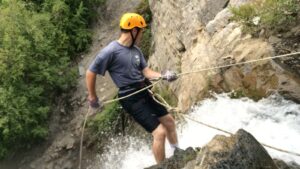
What is Rock Climbing?
Rock climbing is defined as the sport of climbing a rock face by using ropes and special equipment. The goal is to reach the top without falling, but the rope will catch you just in case. To be skilled at rock climbing you need strength, endurance, agility, balance, and mental focus. It seems like the strongest person would be the best at rock climbing, but this is not usually the case. Strength isn’t necessarily always your best friend in rock climbing, but carefully placed footing and hand holds will help you succeed. You can climb indoors on specially constructed fake rock walls, or you can climb outdoors at approved spots.
and special equipment. The goal is to reach the top without falling, but the rope will catch you just in case. To be skilled at rock climbing you need strength, endurance, agility, balance, and mental focus. It seems like the strongest person would be the best at rock climbing, but this is not usually the case. Strength isn’t necessarily always your best friend in rock climbing, but carefully placed footing and hand holds will help you succeed. You can climb indoors on specially constructed fake rock walls, or you can climb outdoors at approved spots.
How to rock climb: To begin, the climber puts on a harness and ties into the end of the dynamic rope
and ties into the end of the dynamic rope using a knot called the figure 8 knot. If top roping (see below), the rope has already been attached to the anchors
using a knot called the figure 8 knot. If top roping (see below), the rope has already been attached to the anchors at the top, so the climber follows the rope
at the top, so the climber follows the rope and climbs the rock to reach the top while someone on the ground belays them. The belayer stands on the ground attached to the other end of the rope and pulls it through their belay device
and climbs the rock to reach the top while someone on the ground belays them. The belayer stands on the ground attached to the other end of the rope and pulls it through their belay device to keep the rope tight while the climber is ascending so they won’t fall or swing very far if they let go. The belayer also lowers the climber down at the end.
to keep the rope tight while the climber is ascending so they won’t fall or swing very far if they let go. The belayer also lowers the climber down at the end.

Types of Rock Climbing:
- What is Top Roping? Top roping is a great way to begin rock climbing, or practice a new route because you won’t fall if you let go or slip. The climber is attached to the rope
 which is securely attached to an anchor system
which is securely attached to an anchor system at the top of the rock face.
at the top of the rock face. - What is Lead Climbing AKA Sport Climbing? In lead climbing, falling is expected and planned for. The climber and the belayer need to be very experienced. The climber brings the rope
 up with them while climbing and and attaches it to pre-fixed bolts in the wall as they climb while the belayer feeds them the rope. The bolts follow the path of the pre-planned route to the end. The climber clips the rope through a carabiner system called a quickdraw as they climb. If you fall while top roping, how far you fall only depends on how much slack in the rope the belayer gave you. If you fall lead climbing, you will fall until the rope catches on the last bolt you clipped into, meaning you could fall 10+ feet. Climbers need to knowledgeable and have a lot of practice before lead climbing, but routes can be anywhere from easy to difficult. Most outdoor routes are lead climbs unless you can hike to the top of the climb to lower the rope.
up with them while climbing and and attaches it to pre-fixed bolts in the wall as they climb while the belayer feeds them the rope. The bolts follow the path of the pre-planned route to the end. The climber clips the rope through a carabiner system called a quickdraw as they climb. If you fall while top roping, how far you fall only depends on how much slack in the rope the belayer gave you. If you fall lead climbing, you will fall until the rope catches on the last bolt you clipped into, meaning you could fall 10+ feet. Climbers need to knowledgeable and have a lot of practice before lead climbing, but routes can be anywhere from easy to difficult. Most outdoor routes are lead climbs unless you can hike to the top of the climb to lower the rope. - What is Trad Climbing? Trad climbing is short for traditional climbing and is defined as rock climbing on a non-bolted route. With no permanent anchors
 and bolts attached to the cliff, climbers have to insert their own as they climb. In sport climbing the protection is pre-placed with fixed anchors
and bolts attached to the cliff, climbers have to insert their own as they climb. In sport climbing the protection is pre-placed with fixed anchors permanently bolted into the crag. In trad climbing, the climber inserts what is called cams or pitons into cracks in the rock and then connects the rope as they climb. They must carry this extra hardware with them as they climb.
permanently bolted into the crag. In trad climbing, the climber inserts what is called cams or pitons into cracks in the rock and then connects the rope as they climb. They must carry this extra hardware with them as they climb. - What is Multi-pitch Climbing? Multi-pitch climbing is a climb longer than 1 rope length, ascending up a tall cliff that takes multiple climbs.There is usually a convenient ledge for each belay station where the climber will stop and then belay from the top as their partner climbs up. Then the next climb begins, each one called a “pitch” and each is considered one length of rope, about 200 feet. With sport climbs, each climb is about half the length of the rope or less (you’ll need twice the amount of rope for how high the climb is), allowing the climber to be lowered when finished. Each pitch on a multi-pitch route usually uses most or all of the rope length. The normal length of a pitch is from ledge to ledge where a new belay station can be ready, sometimes resulting in not very comfortable spots to belay, but the belayer is carefully clipped into anchors on the cliff and doesn’t have to worry about falling. Climbing continues until the top of the cliff is reached. Multi-pitch climbs may have permanent bolts, or could be trad climbs where climbers place their own gear.
- What is Big Wall Climbing? Big wall climbing is like it sounds, climbing a really big wall, with many pitches! These routes often take several days, and require the climbers to spend the nights sleeping in a type of hammock system hundreds or thousands of feet above the ground. This is for the most serious rock climbers! California’s Yosemite is a very popular place for this type of rock climbing, with El Capitan at 31 pitches, more than 3000 feet high and typically takes experienced climbers about 4-5 days of climbing.
- What is Bouldering? Bouldering is climbing close to the ground without the use of a rope. Bouldering routes are rarely more than 15 feet high and can be done on boulders or at the base of a rock face. Falling is normal and crash pads are placed on the ground with a spotter ready. Bouldering is focused on the moves and technique, used for practicing traverses, weight transfers, and foot and hand placements. It is popular because it is less expensive since minimal gear is needed, and can be a good substitute for climbers living in flat landscapes without tall cliffs to climb.
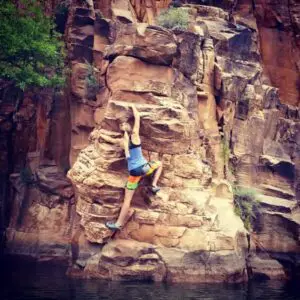
- What is Deep Water Soloing AKA Psicobloc? You have either done this type of climbing, or you have no idea what it is. Very popular with people who know about it, and not really known besides that. Yet! Deep water soloing, known as DWS or Psicobloc, is a type of free climbing without ropes
 or equipment that relies on the presence of water at the base of a climb to protect from a fall. It can be done on sea cliffs, lakes, and swimming pools where there are climbing cliffs above deep water. A small boat or raft is often nearby in case of a hard fall into the water. The term Psicobloc is translated to mean “psycho bouldering.” Routes can be short like bouldering, or a lot higher. This type of climbing is relatively new and became popular in the early 2000s from some climbing movies where rock climbing pros tried it out. The Psicobloc Masters competition is making the sport more popular! It takes place each year in Park City, Utah on a climbing wall that curves above a deep pool. Climbers race up the route with no protection and either make it to the top, or slip and fall into the pool. The winner then has to descend by cliff jumping 50 feet into the water. The climbing wall is also open to the public to experience.
or equipment that relies on the presence of water at the base of a climb to protect from a fall. It can be done on sea cliffs, lakes, and swimming pools where there are climbing cliffs above deep water. A small boat or raft is often nearby in case of a hard fall into the water. The term Psicobloc is translated to mean “psycho bouldering.” Routes can be short like bouldering, or a lot higher. This type of climbing is relatively new and became popular in the early 2000s from some climbing movies where rock climbing pros tried it out. The Psicobloc Masters competition is making the sport more popular! It takes place each year in Park City, Utah on a climbing wall that curves above a deep pool. Climbers race up the route with no protection and either make it to the top, or slip and fall into the pool. The winner then has to descend by cliff jumping 50 feet into the water. The climbing wall is also open to the public to experience. - What is Ice Climbing? Ice climbing is like rock climbing, but using ropes and protected climbing to ascend frozen walls of water. You can either climb places of water flow like a frozen waterfall or icy cliffs found beneath water flows. A climber uses equipment based on the type of ice, such as crampons, ice axes, ice screws, and other ice tools for protection. The strength of the ice is surprising and protection doesn’t need to be placed very deep to hold the climber. Rope systems are also used like in rock climbing with a belayer. Ice climbing is still very dangerous and not for the inexperienced climber!
- What is Aid Climbing? Aid climbing is where a climber uses devices attached to the bolts to stand and pull oneself up the cliff. It is often used when free climbing isn’t a possibility for a serious climber, aid climbing gets them through the hard sections. Aid climbing is similar to trad climbing in that equipment is placed for protection while climbing, but in aid climbing a daisy chain (a ladder made of webbing loops) with an aider is attached between bolts so a climber can “walk up” the daisy chain and stand up to reach farther. It is slow and uses a lot of gear.
- What is Free Soloing? Basically, never try this. Free solo climbing or free soloing is an intense form of free climbing where the climber forgoes ropes
 and protective gear. The climber relies only on strength, endurance, and climbing ability to avoid any falls. It’s very dangerous and usually only 2 types of people attempt it, the crazy idiots, and the most experienced climbing professionals. These guys often make the headlines, either for insane climbs, or obituaries. It’s not safe and not recommended!
and protective gear. The climber relies only on strength, endurance, and climbing ability to avoid any falls. It’s very dangerous and usually only 2 types of people attempt it, the crazy idiots, and the most experienced climbing professionals. These guys often make the headlines, either for insane climbs, or obituaries. It’s not safe and not recommended! - What is Short Roping? Short roping is when 2 climbers are tied together as they climb, one higher than the other. They belay each other in a sense and have multiple spots of protection in between in case of one falling.
- What is Speed Climbing? I thought I’d throw in a little bit about speed climbing because that’s what we are going to see in the upcoming Olympics now that climbing has been added as a sport! The medal will go to the overall winner of bouldering, sport climbing, and speed climbing. Speed climbing is where climbers compete on a route (usually side by side) fighting for the fastest time. In a gym, usually autobelayers are used so that a human belayer doesn’t have to try to keep up with the quick climber. The challenge isn’t necessarily in climbing the route, it’s in climbing it the fastest. Professional climbers fly up a route in speed climbing competitions, finishing in under 6 seconds on a 15m route.

Gear needed to rock climb: Harness , dynamic rope
, dynamic rope , climbing shoes, belay device, locking carabiner
, climbing shoes, belay device, locking carabiner , helmet,
, helmet, chalk bag, and potentially quick draws, extra slings, climbing protection, and crash pads depending on the climb.
chalk bag, and potentially quick draws, extra slings, climbing protection, and crash pads depending on the climb.
Top places to rock climb: Yosemite in California, southern Utah, Thailand, and anywhere with a cliff and some anchors.
Slang: The next important skill is to know your rock climbing slang. Here’s some practice. To not look like a gumby at the crag, clip at least 30 extra cams in your rack with your biner. I’ll give you the beta if you want to redpoint. Chalk up before you send because getting to the crux will be chossy and there are no jugs. My Grigri will catch you if you take a whipper.
What is Caving or Spelunking?
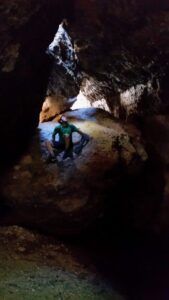
Caving, also known as potholing in the UK, is cave exploration using many of the same techniques and gear as climbing and rappelling. Beginners call it spelunking, but if you’re serious it’s called caving. The challenge with caving is the absence of light as well as varied temperatures, tight spaces, water hazards, and rappels or climbs. Caving is for adventurers and also for researchers and scientists (called speleology). Caving involves walking on uneven terrain, crawling and squeezing through passages, and climbing up and down into different sized rooms in the cave. Sometimes there will be drop offs for a rappel
or climbs. Caving is for adventurers and also for researchers and scientists (called speleology). Caving involves walking on uneven terrain, crawling and squeezing through passages, and climbing up and down into different sized rooms in the cave. Sometimes there will be drop offs for a rappel or places to climb, which is why you would need climbing equipment. Many caves are parts of National Parks and require you to follow a guide through the cave. Other caves are private and also require special permissions to enter.
or places to climb, which is why you would need climbing equipment. Many caves are parts of National Parks and require you to follow a guide through the cave. Other caves are private and also require special permissions to enter.
Gear needed for caving: Helmet with a head lamp, extra batteries, sometimes you will need rope
with a head lamp, extra batteries, sometimes you will need rope , harnesses
, harnesses , ascenders, and other climbing or rappelling gear.
, ascenders, and other climbing or rappelling gear.
Top places to go caving: There are many National Parks with caves to explore as well as private caves. For best caving adventures around the world: Waitomo glowworm caves in New Zealand, Natural Bridge Caverns in Texas, Vancouver Island in Canada, Hang Son Doong in Vietnam.
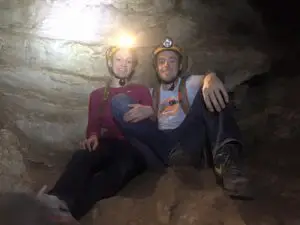
What is Mountaineering or Mountain Climbing?
Mountaineering is the sport of mountain climbing involving trekking up mountains, usually involving snow and ice, to reach the summit. Mountaineers might have to use snow shoes or cross-country skis, ropes, ice axes, crampons, and even equipment for camping in the snow. There is special footwork technique to learn and equipment to master depending on the terrain. Rope systems are sometimes used to tie climbers together to protect from a sudden fall through thin ice.
Popular places to go mountaineering: the Alaska range, Rocky Mountains, Alps, Andes, Himalayas and Mt. Everest of course!
What is Via Ferrata?
Via ferrata is a protected climbing path across a dangerous cliff or mountain route. It includes a steel cable that runs along the route and is fixed to the rock. Climbers secure themselves to the cable with a via ferralta kit so they won’t fall. (The via ferralta kit includes a lanyard that connects to the cable and 2 carabiners and a harness.) Other aids are involved such as metal rungs for stairs and hand holds, steps, ladders, and bridges. Via ferrata is for the beginner as well as the experienced to access difficult peaks as relatively easy and rewarding routes have been created.
Popular places for Via Ferrata: there aren’t too many options in the U.S. due to regulations and liability, but via ferrata is especially popular many places in Europe. You can find routes in the Dolomites in Italy, Chang Kong in China, Telluride in Colorado, Valais in Switzerland, Sacred Valley in Peru.
In Conclusion..
So whatever climbing sport you choose, become experienced and safe and learn the right technique. There are many types of climbing activities you can do no matter where you live, so get out there! What is your favorite sport listed and what variations did we miss?

